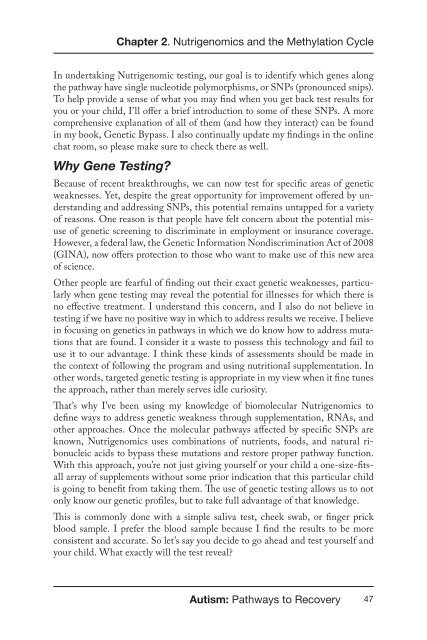3dT4E4Rnm
3dT4E4Rnm
3dT4E4Rnm
You also want an ePaper? Increase the reach of your titles
YUMPU automatically turns print PDFs into web optimized ePapers that Google loves.
Chapter 2. Nutrigenomics and the Methylation Cycle<br />
In undertaking Nutrigenomic testing, our goal is to identify which genes along<br />
the pathway have single nucleotide polymorphisms, or SNPs (pronounced snips).<br />
To help provide a sense of what you may find when you get back test results for<br />
you or your child, I’ll offer a brief introduction to some of these SNPs. A more<br />
comprehensive explanation of all of them (and how they interact) can be found<br />
in my book, Genetic Bypass. I also continually update my findings in the online<br />
chat room, so please make sure to check there as well.<br />
Why Gene Testing<br />
Because of recent breakthroughs, we can now test for specific areas of genetic<br />
weaknesses. Yet, despite the great opportunity for improvement offered by understanding<br />
and addressing SNPs, this potential remains untapped for a variety<br />
of reasons. One reason is that people have felt concern about the potential misuse<br />
of genetic screening to discriminate in employment or insurance coverage.<br />
However, a federal law, the Genetic Information Nondiscrimination Act of 2008<br />
(GINA), now offers protection to those who want to make use of this new area<br />
of science.<br />
Other people are fearful of finding out their exact genetic weaknesses, particularly<br />
when gene testing may reveal the potential for illnesses for which there is<br />
no effective treatment. I understand this concern, and I also do not believe in<br />
testing if we have no positive way in which to address results we receive. I believe<br />
in focusing on genetics in pathways in which we do know how to address mutations<br />
that are found. I consider it a waste to possess this technology and fail to<br />
use it to our advantage. I think these kinds of assessments should be made in<br />
the context of following the program and using nutritional supplementation. In<br />
other words, targeted genetic testing is appropriate in my view when it fine tunes<br />
the approach, rather than merely serves idle curiosity.<br />
That’s why I’ve been using my knowledge of biomolecular Nutrigenomics to<br />
define ways to address genetic weakness through supplementation, RNAs, and<br />
other approaches. Once the molecular pathways affected by specific SNPs are<br />
known, Nutrigenomics uses combinations of nutrients, foods, and natural ribonucleic<br />
acids to bypass these mutations and restore proper pathway function.<br />
With this approach, you’re not just giving yourself or your child a one-size-fitsall<br />
array of supplements without some prior indication that this particular child<br />
is going to benefit from taking them. The use of genetic testing allows us to not<br />
only know our genetic profiles, but to take full advantage of that knowledge.<br />
This is commonly done with a simple saliva test, cheek swab, or finger prick<br />
blood sample. I prefer the blood sample because I find the results to be more<br />
consistent and accurate. So let’s say you decide to go ahead and test yourself and<br />
your child. What exactly will the test reveal<br />
Autism: Pathways to Recovery<br />
47


